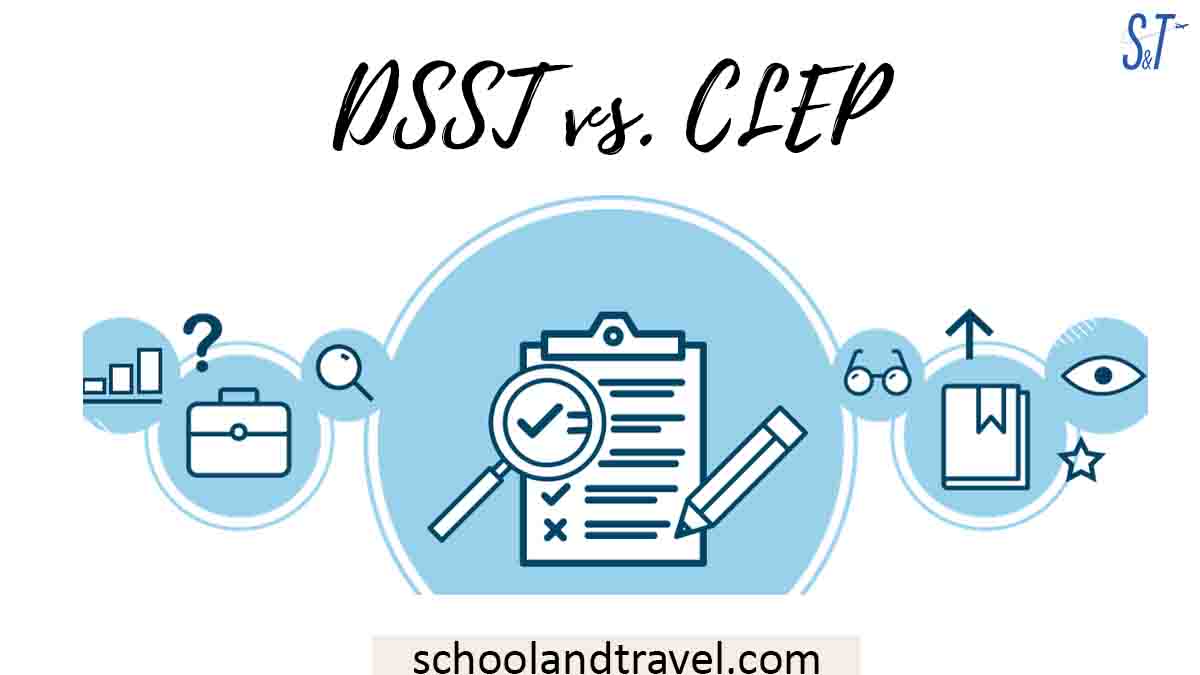As high school students prepare to take their Advanced Placement and look forward to earning college credits, two lesser-known ways to earn those college credits through exams are the DSST and CLEP tests.
Anyone considering a standardized testing method to earn college credits towards their degree; the DSST and the CLEP can be just what they need.
DSST and CLEP are credit assessment programs that allow anyone to earn credits for college courses by taking and passing exams in various subject areas.
These credit assessment services allow students to skip classes they already know the basics of, saving them time and money.
By passing these exams, military and civilian students can receive college credits toward graduation.
This article will give major details on DSST and CLEP, stating the similarities and differences.
DSST vs. CLEP
What is DSST?
DSST stands for DANTES Subject Standardized Tests. The DSST began as a test that offered college credits to military personnel.
It is currently managed by Prometric and provided to anyone trying to earn college credit outside the four walls of a school. It offers 30 exams in six subject areas. Presently, 1,900 schools accept DSST points in the US.
What is CLEP?
CLEP stands for College Level Examination Program. CLEP exams include college-level beginner’s materials and help students earn college credits for what they already know.
The College Board manages CLEP. However, thirty-four tests cover five subject areas, including History and Social Sciences, Literature and Composition, Science and Mathematics, Business, and World Languages.
These tests have good credit ratings at more than 2,900 colleges and universities. Thus, any student looking to earn credits can take the CLEP testing, including military personnel, college students, and homeschooling students.
There is no age or financial gain limit.
DSST vs. CLEP: Similarities
- DSST and CLEP exams assist students in earning college credit. Both enable students to achieve their goals, be it to start their careers or save money.
- The DSST and the CLEP together support credits for a spread of grades, and both are licensed by the American Council on Education (ACE) to issue out credits based upon written tests.
- The two exams contain multiple selection questions and are written either on a laptop or paper-based on requests.
DSST vs. CLEP: Differences
- Despite the fact that the two tests cover some of the same material, there are courses that only one covers: CLEP exam requires comprehensive tests like ”Human Growth and Development” and “American Literature”.
In contrary, DSST consists of courses like “A History of the Vietnam War” and “Principles of Public Speaking” that college will settle for in an exceedingly different variety of ways.
- CLEP exams last 90 minutes while DSST exams last 2 hours.
- All CLEP exams are worth “lower-level credit”, which fills the 100 and 200 level gaps in a degree. DSST, on the other hand, has various exams that are worth “upper-level credit” and fill the 300 and 400 level gaps in a degree.
DSST vs. CLEP
Important details about DSST and CLEP
While the DSST and CLEP are different products, they both deliver the same result: providing college credits that service members and civilians could use towards graduation without going to a classroom.
Other important details about DSST and CLEP that should be considered are:
Access:
In the early 2000s, DSST exams were restricted to military personnel, however, you will still notice several DSST examination centres placed within military facilities.
Now, these exams are open to civilians and military personnel alike. CLEP exams have always been accessible to civilians, so your exam centre may be located within a college or university.
Both brands have a “Test Center Locator” feature on their website, allowing you to explore all of the test centre options. However, CLEP also offers a remote examiner option to take exams from your computer.
If you choose this option, you will pay $30 monitoring fee.
Read this: Fellowship vs. Scholarship vs. Studentship (Major tips)
Exam Format:
DSST and CLEP exams are multiple-choice exams, and each requires about the same length of questions (that is 100) and take about the same time (that is 90-120 minutes).
Note: You have five choices for each CLEP question. For each DSST question, you will have four possible options.
Exam Acceptance:
Technically, CLEP is more popularly accepted than DSST. So if you have not chosen a target university, you should select CLEP over DSST.
This means that when you are trying to maximize the credits per exam or make as many academic achievements as possible, you should choose an exam-friendly university before the exam begins.
On the other hand, many schools only accept selected tests, and it’s up to the student to know which ones. As a result, any examination not offered by the student’s preferred school may be useless.
Credit Rewards:
There is almost no duplication of credit between the 34 CLEP and 30 DSST exams available to you. This implies that you will choose between over 60 examination subjects at an exam friendly university.
DSST exams are worth three college credits each, whereas CLEP exams are worth 3 to 9 credits based upon the courses taken.
Note: In the case of uncertainty, you can reschedule either CLEP or DSST but have to wait 30 days before retaking a DSST test and three months before retaking a CLEP test.
This may be problematic to your study plan, and you will have to spend time studying for the exam again.
To avoid this problem, the most obvious thing to do is to pass the exam the first time by studying effectively.
Read this: Most Useless Degrees you won’t even believe
Anyone can take DSST and CLEP exams:
Both tests carry the misconception that they are only intended for adult students, however, high school students are more likely to be credited through Advanced Placement tests.
Again, the DSST and CLEP tests are accessible to anyone who desires to acquire them.
They save you both time and money:
To sit for DSST and CLEP exams will cost you $85 and $100, respectively.
For financial reasons, passing a CLEP or DSST exam saves you the time of sitting in a class and relearning the knowledge you have already acquired. On the other hand, the exams are usually multiple-choice and short-timed.
Structure of the Tests
The structure of these tests are similar, but there are noteworthy differences that students need to understand before enrolling.
The CLEP exam provides students with five potential answers to the question, whereas DSST offers four. At the same time, each CLEP test must be completed in 90 minutes, while the DSST test allows students two hours.
In some subjects, the CLEP exam consists of an essay component together with multiple-choice questions.
Awarding of Credits
Each institution has its guidelines for accepting DSST and CLEP credits. When meeting with the school’s counsellor, students ought to raise the subsequent questions:
- What tests does the school accept?
- How much credit is each exam worth?
- Is the test good for a degree or an elective?
- How much total credit does the school accept through tests?
- What is the least score the college can settle for on every test?
Conclusion
The concept backing DSST and CLEP exams is that students who already have in-depth information about a course should not waste time relearning it.
Students seeking college credits for prior knowledge in a subject should consider two options: the College-Level Examination Program (CLEP) and the DANTES Subject Standardization Test (DSST).
The duo exams can be likened to final undergraduate school course exams. These exams are handy tools for anyone following a college degree.
In addition, they can save you time and money by eliminating the need to repeat courses that you just have already got ample information in.
Awesome one; I hope this article answered your question.
Share this Information.
Related articles:
- How to Create a Balanced Plate: The Key to Healthy Eating
- How to Start a Virtual Book Club with Friends
- The Top Credit Score Hacks Every Young Adult Should Know
- The Pros and Cons of Rental Property as a Passive Income Stream
- Enhancing Your Clinical Psychologist Job Prospects with Professional Help
- The Impact of Graphic Design School on Your Future Earnings Potential
- 7+ College Scholarships for Muslim Students (FAQs)
- Flavor of the Month Scholarship 2024 (Requirements, FAQs)
- Vegetarian Scholarship (Requirement, Deadline, FAQs) | 2025
- John and Abigail Adams Scholarship 2022-2024 (Eligibility, Deadline)


